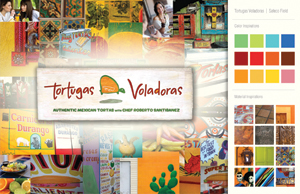“Who practices hospitality entertains God Himself.”
Unknown
Food is way more than what we eat. It can show love, it can bring strangers together, it can excite, it can create memories, it can talk to people in ways few other things can — and yes, it can also feed and sustain us. As powerful as food is, it is just one dimension of the hospitality experience. Great restaurateurs know this as fact.
The future as we see it has food experiences in sports evolving into hospitality experiences, where all the elements of buying and enjoying food speak to the customer in a clear, welcoming voice. At Stir we apply resources from many disciplines to achieve this clarity of voice. One of our more compelling approaches is to translate the guiding principles and practices of top-flight restaurants to the development of our concepts, in turn applying the sensibilities of a restaurateur to the planning and design of our projects. In the process, we’ve landed on what we call the Seven Golden Rules of Restaurant-Real Hospitality. This article outlines these rules, and then describes the results of applying these rules to creating the concepts for the soon-to-open Pen at Safeco Field.
These rules have been culled from working with great chefs around the world and from having in-depth discussions with them on how to bring together the two very different worlds of fine restaurants and sports foodservice. So to make it “restaurant-real,” do the following as does a restaurateur:
1. BUY: Great restaurants are as much about what they buy as what they do with it. Chef Donald Link of Cochon and Herbsaint in New Orleans actually employs a full-time forager to comb the local markets and purveyors for specialty, small-lot ingredients and products. To create hospitality experiences in sports, we must build the experience from the same supply chain as local top chefs.
2. TASTE: While Dave Pasternack was writing his cookbook, “The Young Man and the Sea,” his publisher would call him up and ask if he could put a few more ingredients in his recipes. Typical Dave — he is the master of balance and clarity, and anyone who’s had the crudo at his restaurant Esca in New York City, knows this firsthand. For Dave, one of the issues he has with some chefs is what he refers to as “always three too many ingredients.” Like Dave, in sports we should strive for clean, simple flavors — and you don’t have to be a foodie to notice. People get clean food, even in a stadium.
3. CONNECT: Prime Meats in Brooklyn is a nationally recognized restaurant that is, to me, the best, most recent example of connecting all the dots: food, service style, uniform, aesthetics, graphics and atmosphere. Everything speaks to the customer in one voice with the result being an incredibly comfortable and enjoyable place to eat and drink. To create restaurant-real experiences in sports we must go well beyond designing concession operations. As Frank Falcinelli and Frank Castronovo at Prime Meats have done, we must work to use every visual, sensory and experiential cue available to us to talk to the fan.
 |
COURTESY OF CENTERPLATE STIR
The mood board helps set the concept and feel for Tortugas Voladoras, one of the new hospitality areas at The Pen at Safeco Field. |
4. DESIGN: When designing a concession or a suite program, you generally start with a menu. When a restaurant is designed, you start with a concept. If you want restaurant-real, you need to design as if you are designing a restaurant — the process is the same. We should ask ourselves: “What’s this concept about? What’s it feel like to be at and eat in this place?” At Stir we first create a mood board, using the award-winning Sam Cooper Design to design the road map. After these two steps, then we get to menu and the rest, same as if designing a restaurant.
5. ENGAGE: Seattle-based chef Ethan Stowell told me that a key to any great restaurant is to engage with the community. This engagement with the community requires dedicated effort. Ethan has Kirsten Graham who handles this for him in Seattle, and to get to hospitality we too must connect to the restaurant community specifically, and to the community as a whole generally.
6. PLAN: Growth is what happens when you’re not operating. Top chefs and restaurateurs are on a never-ending road of discovery, always striving to keep the concept vital and relevant. Planning is an everyday affair in leading restaurants, and in sports with the complexity of very high sales volumes in very compressed periods of time, planning cannot be relegated to the offseason. It must be an ongoing commitment, separate and distinct from day-to-day operations.
7. THINK: Getting an operation the size and scope of a sports stadium to think like a restaurateur is no small task. Our strategy is to bring top local chefs into our projects and into our kitchens as part of our team. And through this association we inform our kitchens and operations with the sensibilities of a restaurateur.
The Pen at Safeco Field
These rules were recently applied to the design of The Pen at Safeco Field. We worked with the Mariners and top chefs to create four new hospitality concepts, opening Friday:
• Hamburg + Frites: We collaborated with chef Ethan Stowell to create the “anti-fast food burger”: A tasty 6.5 ounce patty of 100 percent grass-fed beef from local supplier Thundering Hooves. Topped with Tillamook Cheddar and butter lettuce, this burger has a clean, fresh flavor.
• Apizza: Here’s a serious attempt to raise the pizza bar in sports. Our chef partner Bill Pustari, owner of one of the nation’s top pizzerias, Modern Apizza in New Haven, Conn., is helping us to create authentic, thin-crust pizza at Safeco. We use the same mozzarella cheese and the same San Marzano tomatoes at Apizza as Pustari does at Modern. We use Zoe’s local pepperoni and offer a white pie with local veggies that changes seasonally.
• La Creperie: This is authentic Parisian street food, crisped and folded into a triangle to be eaten with one hand, with both sweet and savory variations. To make it Seattle-relevant, we worked with Stowell to create savory fillings based on local supplier Zoe’s all-natural meats.
• Tortugas Voladoras (Flying Turtles): In Mexico, tortuga is the slang term for a torta, because the bread used to make these sandwiches looks like a turtle’s shell. Tortas are an up-and-coming trend in the U.S. and we brought in renowned Mexican chef Roberto Santibañez to work with us to create an authentic Mexican torta shop, again using all local meats and poultry sourced through Stowell.
We actively applied the Seven Golden Rules to inform our work at Safeco Field. It’s like the Richard Cushing quote “When I see a bird that walks like a duck and swims like a duck and quacks like a duck, I call that bird a duck,” applied to hospitality design. By doing things the way a top chef or restaurateur does, we can transform a concession stand into a hospitality experience.
John Sergi (John.Sergi@Centerplate.com) is chief design officer of Centerplate Stir, where he develops hospitality and culinary strategies for sports facilities throughout the U.S. and overseas.





